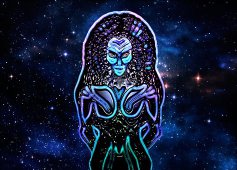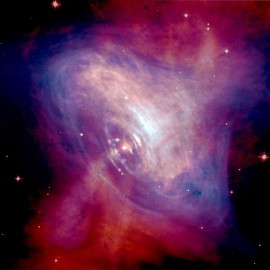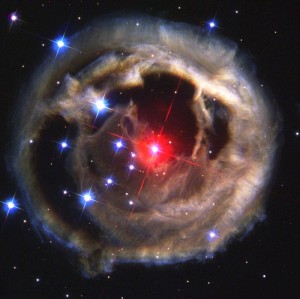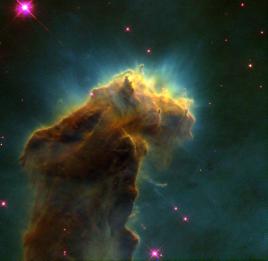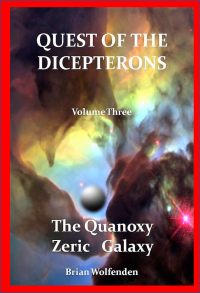The Quanoxy Zeric Galaxy
How it all Began
‘At the end of Volume Two we left Olivia, Scott, Zac and Seren in a most precarious position in their space shuttle above the crippled Dicepteron disc which was about to implode as its internal star entered the supernova stage. Above them in the retreating second disc were Ella and Chuck who were unaware of the occupants of the space shuttle that they had seen exit the lower disc.
‘However, before I tell you what happened next, I think it is appropriate that you know something about the Dicepterons who, I’m sure you will agree, are a formidable and frightening alien species. In particular, you may be wondering where they came from and how they achieved their mind-blowing technology. So let’s go way back in time and to another star in the Milky Way galaxy and visit a planet not too dissimilar to Earth in size and position from its star.’
Ѳ Ѳ Ѳ Ѳ Ѳ
Chapter One
Seven Hundred Million Years Ago
They did not know that disaster was about to strike. How could they? Their perfect world had not experienced an earthquake or volcanic eruption for hundreds of thousands of years. They had become complacent, ignoring warnings that their planet was overdue a cataclysmic event. Life had become so easy: just eating, drinking, playing and reproducing. After all, the machines did everything for them, specifically producing the vast amount of food that they consumed. They had become totally reliant on the technology that their advanced predecessors had designed for them.
There were billions of them living along the fringes of the oceans and the vast estuaries and rivers that criss-crossed the land masses near the equator of this planet. This life form had evolved in the sea and, in the planet’s distant past, had themselves been the primary food-source for the sophisticated creatures that once dominated the planet. But these land based forms had suddenly become extinct after a catastrophic environmental change on the planet. Only sea based life survived and, fortuitously, the sophisticated food processing factories and an extensive underwater fishing fleet.
The two-metre long shrimp-like creature emerged from the hot sea and raised its armour plated body on rows of powerful segmented legs. Its surface glistened with a mix of iridescent red, green and turquoise colours. It moved surprisingly quickly up the shallow incline of the sandy beach and into the shade of a large structure which was certainly not of natural origin. It was quickly followed by over a thousand similar creatures of varying sizes from one to three metres in length. They formed an impenetrable armoured mass as they surged up to the shoreline to gain protection from the intense heat of their midday star. This exodus of marine life from the sea was occurring at thousands of similar beaches around the equator of this planet. It was driven by the midday sun and the high tide that would follow three hours later.
The unusual structure spanned the width of the five hundred metre cove and formed a shallow reservoir which was fifty metres wide. It was covered by a huge dome-shaped roof which shaded the area from the harmful rays of the star. On its land side was a raised platform backed by a wall whose vertical surface was an array of screens, levers and switches. Lights blinked in various colours and each display carried the same flashing message.....
WARNING – PRESSURE AT INTERFACE E-G TECTONIC PLATES REACHING CRITICAL – EARTHQUAKE IMMINENT
Ѳ Ѳ Ѳ Ѳ Ѳ
‘You may be wondering how we can be at another star and on a planet where there are screens displaying a warning message in English. In reality a series of indecipherable characters was displayed which needed Zac’s understanding of Dicepteron code to translate at a later date. Also, if the previous highly intelligent civilisation had survived, they would have acted appropriately by shutting down nearby genetic processing factories and the Dicepterons may not have actually evolved!
‘These huge reservoirs at the top of the beaches had a dual function for both the previous, but now extinct life forms, and the marine life that currently filled them to capacity. They were a relaxation area with protection from the extreme heat and radiation of the planet’s star and .....’
Ѳ Ѳ Ѳ Ѳ Ѳ
The noise level in the pool was increasing. It was caused by the clashing together of their armour plates and the repeated snapping of sharp claws at the ends of the front limbs of the mega-shrimps. Situated between these legs were two compound eyes on flexible stalks and below a multi-structured mandible yawned open in anticipation. The creatures raised themselves up on their rear sets of limbs and crashed into each other as they vied for position in the pool. Water frothed and splashed around them as the larger shrimps fought their way to the front edge of the reservoir facing the ocean. Now they all faced the incoming tide, constantly clicking their claws.
The sea reached the top of the beach and started overflowing into their compound. The clicking intensified. Out in the ocean a white mist developed across the width of the cove and rolled slowly towards the land. As it grew in height it changed in colour becoming grey and then darkening to black as it neared the front edge of the structure. The clicking was deafening and all the creatures had risen up pressing against the backs of their neighbours directly in front. As it reached the front edge of the pool the black mass reared up and turned back on itself, reversing towards the ocean. In its wake a huge off-white mound was deposited across the width of the front edge of the structure.
The stampede was instantaneous and cacophonous. Smaller, weaker shrimps were trampled by the rush, their shells cracking under the weight. The larger creatures at the front rushed up the mound clawing the soft substance into their mouths. It was a feeding frenzy with intense competition to devour the maximum amount of food. Limbs were severed as they fought one another for every last scrap. When all the food had been consumed, they turned on the trampled and injured shrimps and ripped out their soft flesh. As the tide turned, the satiated creatures returned to the sea. The black mass and mist had disappeared.
The warning messages still flashed.
Ѳ Ѳ Ѳ Ѳ Ѳ
‘A mist at the edge of the sea and a black mass! Sounds familiar. The off-white substance was a highly concentrated and nutritious shrimp cocktail which had been the staple diet of the previous civilisation. Now the giant shrimps, that had subsequently evolved after the extinction of the former intelligent species, took advantage of this regular daily supply of food. The quantities deposited and consumed on the shores of this planet were phenomenal.
‘In the oceans, fleets of vessels trawled the ‘baby’ shrimps and processed them into the concentrated food that was then delivered to every shoreline at high tide after the midday sun. These sub-sea craft were disc shaped with convex upper and lower sections and a rotating vertical surface with hexagonal openings. At the centre of each was a cold fusion nuclear power plant and this and the various processing streams were controlled by an on-board artificially intelligent [AI] computer.
‘Near the poles of this planet, similarly designed undersea structures mined the seabed for silicon, aluminium, vanadium and rare elements. These were the building blocks of their land and sub-sea structures and the complex AI computers controlling them.
‘As you might infer, an extremely advanced civilisation had existed here and we will revisit this planet later in my story. Of key importance is what happened next and how this led to the evolution of the Dicepterons.’
Ѳ Ѳ Ѳ Ѳ Ѳ
Chapter Two
Earthquake
Dotted across the equatorial land-masses were thousands of dome-shaped structures, surfaces glinting in the fierce light of their star. They varied in size from one to ten kilometres in diameter and they were clustered together in a formation of twenty smaller structures radially positioned around the central large building, resembling ‘mini-cities’. They were located close to the coastlines and estuaries and were individually interlinked by large pipes which served as access corridors. Their surfaces were fabricated from small concave panels which were nested together giving a surface appearance not too dissimilar to a golf ball. At the very edges of the coastline the dome structures covered huge rectangular pools of water – the relaxation and feeding centres.
The atmosphere was severe. Day-time temperatures soared in excess of sixty degrees Celsius and ultra-violet radiation was so high that life could not exist outside the protection of these domed structures. But it could in the sea itself which absorbed the harmful radiation. However, there was no longer life under these structures, although various complex processes continued to operate and multiple displays flickered with data showing their status. Many of these screens flashed the message....
WARNING – PRESSURE AT INTERFACE E-G TECTONIC PLATES REACHING CRITICAL – EARTHQUAKE IMMINENT
Ѳ Ѳ Ѳ Ѳ Ѳ
‘The major continents and oceans of Earth are situated on fifteen primary and secondary tectonic plates. These are about one hundred kilometres in depth and they float on the molten magma below the crust. They are always moving, albeit very slowly, and the interfaces of these plates cross continents, countries and lie below the seas. Most of the time the edges of these huge masses move smoothly past one another with minimal friction. Occasionally they jam together and pressure builds below until one plate suddenly moves [up or down] relative to the other. The result is an earthquake – a sudden violent shaking of the ground or where the event takes place under the sea – a tsunami. Many populated areas are situated above these interfaces – the most famous being San Francisco on the San Andreas Fault which resulted in the nineteen hundred and eight ‘quake.’
Ѳ Ѳ Ѳ Ѳ Ѳ
It was an apparently normal day on the planet as the huge shrimp-like creatures scampered up the beach and into the shade of the huge pool. The noise level increased as the mist formed on the sea and the black mass rolled towards their position and deposited the food in front of the hungry crustaceans. Then the earth shook violently, the walls of the pool cracked open and the massive domed roof collapsed onto the surging mass. The shaking continued for many minutes followed at regular intervals by aftershocks. Most of the creatures were crushed by falling debris but some completed their feeding and returned to the sea. Many nearby feeding stations along the coast were also destroyed but the total loss of life to the mega-shrimp population was relatively small.
However further inland, and for a huge swathe of the planet around its equator, the devastation was appalling. One third of the dome-shaped structures were completely destroyed. In the estuaries, critical food processing structures collapsed and tanks containing concentrated ingredients spilt their entire contents directly into the rivers.
Ѳ Ѳ Ѳ Ѳ Ѳ
‘On Earth the highest recorded earthquake was nine point two on the Richter Scale in Japan in two thousand and eight. On this planet it measured eleven point three on the same scale, over one hundred times more powerful.’
Ѳ Ѳ Ѳ Ѳ Ѳ
Chapter Three
Genetic Engineering
The huge shoal of crustaceans exited the hot sea and swam up the estuary against the flow of the river. They were the same species as the mega-shrimps but very much smaller. Surprisingly, they were all exactly twelve centimetres in length and of identical age, equivalent to twenty-five revolutions of their planet. As the depth of the water decreased, they caused a multicoloured turbulence on the surface. From above, they appeared as a solid iridescent mass snaking through the river as they moved further inland.
They were all female and their abdomens were crammed with, as yet, unfertilised eggs.
This species had been cloned and genetically engineered to provide a continuous source of food delivered on a daily basis to the leisure pools at the top of the beaches. Now they sustained the mega-shrimps that had evolved since the demise of the previous intelligent life forms that had designed this remarkable food chain.
As the river narrowed the water became hazy, then milky until finally the shoal was swimming through a white mass of fertilised eggs which were flowing in the opposite direction.
This process was replicated on a daily basis in all the estuaries around the equator. It had been happening for hundreds of thousands of years, perfected by intelligence and maintained by highly sophisticated computers.
But all that was about to change.
There was no intelligent life left to heed the warnings of a major earthquake.
Ѳ Ѳ Ѳ Ѳ Ѳ
The shoal of crustaceans finally reached its destination and swam away from the dense mass of fertilised eggs issuing from one of the three large structures that straddled the river. They moved into clear calmer water before being sucked into the first domed-building of the genetic processing plant. Here they were bombarded with microwave radiation which caused each shrimp’s abdomen to spasm, ejecting the eggs which were separated from the now lifeless hulks.
These eggs moved into the second structure where they were split into flows of similar numbers and passed into two separate fertilisation units. Here genetically manufactured sperm was mixed with the eggs which then underwent modification of their DNA by the injection of a microscopic amount of a virus, not too dissimilar to e-coli. Two distinct groups of fertilised eggs were produced. One was one hundred per cent male with the genetic code altered to produce meat with exceptionally high protein content. The second was all female modified for maximum egg production. These two streams passed to the third, gestation tank before being ejected into the river to flow downstream to the sea.
The genetic processing plants had been designed to withstand earthquakes up to force ten point five on the Richter scale. However, the one that struck this planet was of unprecedented severity and several facilities near the epicentre collapsed into their rivers. In one of these units the tanks holding the deadly virus split and dumped their entire contents into the river.
Newly fertilised eggs were over exposed and underwent uncontrolled mutations. A huge shoal of female shrimps swimming upstream was wiped out by the concentrated virus which then permeated the seas wreaking havoc and destruction of the marine life. The underwater fishing fleet continued to harvest the male shrimps and process them for food. But the badly mutated versions poisoned the food and this tainted supply was deposited on the beaches every day and consumed by the mega-shrimps. With one third of the processing plants destroyed by the earthquake, the food supply decreased and competition at the beach pools became desperate as too many crustaceans fought for the decreasing supply of food. Their numbers diminished.
The huge mega-shrimp dragged itself up the beach as it had done thousands of times before. It was accompanied by a handful of others which made it to the cover of the pool. The tide came in and the black mass rolled up to the edge of the structure and retreated. But no food was deposited. The weaker shrimps became the last meal for the remaining one which collapsed on the beach half way on its final journey to the sea. The heat and intense radiation completed its demise.
In time all marine life on the planet became extinct.
But the computers were still functioning!
Ѳ Ѳ Ѳ Ѳ Ѳ
Chapter Four
Evolution of the Computer
The fleet of disc-shaped vessels continued their underwater trawling of the seas. Their computers had been pre-programmed for this task and this would have continued ad-infinitum but for the slow demise of the marine stock. Now the black masses returned empty from their fishing expeditions and food processing ground to a halt. Mining of the planets resources continued unchecked and resulted in an excess of raw materials building up in the mining discs. The black masses transported the excess to the fishing fleet.
The AI computers reacted to the change by manufacturing larger discs capable of storing the vast quantities of ore. They also developed larger and more efficient processing streams for the raw materials. They reproduced themselves, building bigger and more capable artificially intelligent computers.
Their evolution snowballed over hundreds of thousands of years until the capacity of the oceans of this planet threatened to limit their growth. They needed water in vast quantities to cool their trillions of circuits, water to produce hydrogen to feed the nuclear fusion driving all their processes. Their discs grew in size and complexity. They were now seventy kilometres in diameter and ten kilometres high and capable of all the synthesising processes necessary for independent existence. Each carried a huge reservoir of water and cylinders crammed full of black beads. The AI computer had evolved to a molecular form based on silicon which could replicate itself. The outer surface of the disc could now be rotated at such speed that it could cleave through the water and rise up into the atmosphere of this planet.
One million years after they ceased producing foodstuff, they had outgrown the planet and now turned their sights towards a nearby sister planet. This was further away from the star with massive ice-poles, small land mass and deep oceans. They refined the drive mechanism such that the outer vertical surface could be rotated in excess of half a million revolutions per minute. This, combined with the concave design of the panels, gave sufficient upward force to counter the planet’s gravity. At an escape velocity of just over ten kilometres per second the first few discs covered the approximately fifty million kilometres to this new world in about one to two hundred days dependant on the relative positions of the planets. The initial landings were catastrophic both for the discs and the planet as they had yet to develop effective reverse thrust. With time they modified the drive mechanism so that the outer vertical surface could be driven in the opposite direction creating a significant braking force. Discs could now enter the oceans of this new world without damage to themselves.
They had inhabited their first new planet and set about mining the minerals and rare metals needed to reproduce themselves and their discs. Then they set about melting the ice caps to increase the depth and area of the oceans and increase the capacity for their extraordinary machines.
The silicon based AI computers at the centre of each disc evolved to a molecular level of computing complexity and became vast amorphous multi-coloured clouds capable of movement throughout the water and moisture within their discs. Each had a massive bulbous eye with retractable tentacles. They could change state from gas to liquid to solid as necessary for their purposes. They could reproduce themselves and continuously improve their incredible sophistication. But they were dependent on water, frequent recharging of their circuits and were confined within their discs.
The oceans of their first planets were crammed with discs, seventy kilometres diameter, each with two occupants.
One hundred thousand highly sophisticated, evolving aliens.
The Dicepterons had arrived.
Ѳ Ѳ Ѳ Ѳ Ѳ
Chapter Five
Next the Stars
The Dicepterons continued to evolve. They perfected their molecular circuitry based on silicon and they grew. They were dependent on water for mobility and cooling and to provide power to recharge their transistors. Their complex ore-refining plants and black bead production units were powered by heat exchangers using the energy generated from their internal mini-star. Super heated steam provided the immense torque to rotate the outer surface for propulsion. This required huge quantities of water fed from an internal reservoir within the disc. This supply could easily be topped up from the oceans of the two planets they occupied and the Dicepterons were able to perfect their processes and make each disc self-sufficient. They could travel much faster between the two worlds as they continued to increase the rotational speed of the outer surface.
They faced two problems limiting future expansion. They were nearing the capacity of both planets’ oceans and the supply of rare elements for their circuits was dwindling. The latter issue was helped by an asteroid strike on the ice cap of their second planet. Analysis of the remains showed that they contained the elements they needed for their computers. However, finding the source took thousands of years and several more asteroid strikes. Finally they located the asteroid belt, two hundred million kilometres away, in this solar system. Discs were dispatched and, reminiscent of their earlier fishing processes, sucked in asteroids and brought them back to the planet. Process plant was modified and the elements were extracted from the asteroids.
Now the search for new suitable planets started. The Dicepterons surmised that other stars would have orbiting planetary systems, and, due to the vast number that could be detected, some of these would carry the vital liquid element for their existence. The nearest stars ranged from ten to fifty light-years in distance requiring travel times of many hundreds of years to reach. But time was of no consequence to the Dicepterons so they sent discs to thousands of potential stars and plotted their progress on huge screens of pure silicon.
Most probes returned negative results but suitable planets were found at new stars and occupation began.
During the next hundred million years, the Dicepterons travelled to the four corners of the Milky Way. They identified seven hundred and fifty potential host planets and occupied over sixty-five per cent of them. The remainder needed further preparation. They were truly star travellers and their complexity and sophistication increased exponentially.
Interestingly, they had found a potentially useful planet which was totally covered in ice. They had discovered Earth or, as it became known later, Snowball Earth. This world was ear marked for future investigation.
Now the Dicepterons were constrained by the Milky Way and their computer eyes looked to new galaxies. But it would take an astounding technical discovery for their next major step and a further one hundred million years to perfect it!
Ѳ Ѳ Ѳ Ѳ Ѳ
Chapter Six
The Six Galaxies
The Dicepterons could travel the vast distances between the stars in the Milky Way galaxy. Time was not a hindrance and, where new planets with adequate oceans were found, these could be used to refill their internal reservoirs. They had refined their discs so that each was self-sufficient for all processes. In particular, they could capture asteroids on route and process these for their rare elements using the black masses to transport them through a microwave radiation field. This, combined with the capability to mine the new planet’s resources for basic minerals, meant they could build more discs and, critically, also reproduce themselves.
Each new planet became a staging post for exploration to new stars. The Dicepterons were becoming a perfect replicating species with no competition or predators. The varying life forms they encountered were either swept aside or found ways to exist under occupation. In some instances the indigenous species was unaware that their planet was also host to the Dicepterons.
Now the enormous eyes of the Dicepterons looked up at the black roof of their control rooms and saw the Milky Way. The planets which they had identified, and those subsequently taken over, were highlighted and it was becoming obvious that they would soon fully occupy this galaxy. Their bulbous orbs moved across the roof and observed a shallow arc of galaxies. The nearest was Canis Major Dwarf and the sixth galaxy from the Milky Way was Formax Dwarf.
The nearer galaxies were reachable with their current capability. It did not matter to them if they took millions of years to reach their targets. However, to travel further afield needed significant improvements in speed and capacity for their craft. They developed the first range of one hundred and forty kilometre diameter discs with modified vertical faces for higher rotation and power. They were capable of speeds approaching one tenth that of light and had vast water reservoirs to sustain their central power plants for the duration of the journeys.
While one of these giant discs was preparing to leave on a journey to a new galaxy, its mini-star suddenly ran out of control and started expanding into the red phase which was the precursor to a supernova. This generated massive extra power which was transmitted to the drive mechanism. The outer surface, already rotating a half a million revolutions per minute, accelerated to in excess of double that rotational speed and the disc shot upwards at near light speed. The expected catastrophic implosion did not occur.
It disappeared!
The Dicepterons increased the power output of their mini-stars trying to reproduce these conditions. There were countless failures but finally more discs disappeared. It would take another million years of refinement before they were able to bring the same disc back. They had found a way to cleave through the fabric of space-time into another dimension, and, equally important, to reverse the process and re-enter the same or another galaxy. Now all the galaxies were reachable in relatively very short periods of time.
After two hundred and fifty million years of evolution the Dicepterons were in six galaxies including the Large and Small Magellanic Clouds. They occupied tens of thousands of planets and continued to probe and test those that were not yet suitable. Earth and Cloud Planet were among many worlds being prepared for the future.
But that did not satisfy them as they were spread across a vast swathe of the Universe. So they built their own galaxy in the empty regions of space beyond Formax Dwarf and moved most of their discs into it. This took a further one hundred million years.
It was their base for the next three hundred million years and they called it the Quanoxy Zeric Galaxy.
Ѳ Ѳ Ѳ Ѳ Ѳ Ѳ Ѳ Ѳ Ѳ Ѳ


